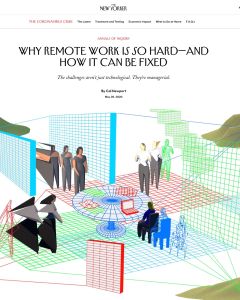Join getAbstract to access the summary!

Join getAbstract to access the summary!
Cal Newport
Why Remote Work Is So Hard – And How It Can Be Fixed
The challenges aren’t just technological. They’re managerial.
The New Yorker, 2020
What's inside?
Business grappled with remote work before COVID; now it faces the challenges and reaps the rewards.
Recommendation
Managers mostly resisted the concept of remote work until the pandemic left bosses no choice but to embrace it. Businesses that sent employees home are still grappling with the disruption. Writing for The New Yorker, Cal Newport, author of Deep Work, lays out the issues facing firms in managing the mass migration to – and from – remote work. Despite losses in team cohesion and informal, in-person communication, remote work can yield satisfying results for everyone – if you pay attention to workflow issues.
Take-Aways
- Technology, especially broadband internet and video streaming, made remote work a realistic possibility, yet business was slow to embrace it.
- The COVID-19 pandemic made working from home necessary, but managers still worry about remote workers’ efficiency.
- At the turn of the 20th century, manufacturers were reluctant to embrace the electric motor – a transforming technology – in their factories.
- “Workflow innovations” allow hybrid solutions that integrate the best features of office and remote work.
Summary
Technology, especially broadband internet and video streaming, made remote work a realistic possibility, yet business was slow to embrace it.
In 2006, Skype inaugurated the era of videoconferencing. Living and working in less congested, less pricey areas with flexible schedules seemed within reach. Timothy Ferris proposed the 4-Hour Workweek, suggesting workers could negotiate remote arrangements and work from wherever they wanted to live.
“Unsupervised by bosses, these ultra-remote workers could do their jobs in highly efficient bursts, enjoying lavish lives of leisure the rest of the time.”
But by 2013, executives’ attitudes toward remote workers soured. Yahoo CEO Marissa Mayer ended remote work for her company, claiming a loss of efficiency and quality, and saying that a remote workforce didn’t form a coherent team. Other tech companies followed, implementing incentives to get workers to stay in the office, including free meals, gyms and coffee stands. Remote, “flexible” work became a perk.
In 2018, only 3% of the US workforce worked more than 50% of their schedule remotely. The technology that workplaces now rely on – email, cloud-based apps and cellphones – enabled work to encroach on workers’ non-work time.
When businesses reopen after the pandemic shutdown, not all workers will come back to the office. Citigroup expects a slow return of its workforce over the next year. Twitter has made all jobs not requiring workers’ physical presence permanently remote. To protect employee health and to limit liability, companies will depend on telework solutions for the foreseeable future.
China rolled back restrictions as about 50% of Microsoft Asia’s workforce returned to the office; the rest still work remotely. Companies have turned to other solutions that allow social distancing at work. For example, staff members at Nanjing University stagger their schedules to reduce the number of people on campus.
The COVID-19 pandemic made working from home necessary, but managers still worry about remote workers’ efficiency.
People who work in the same space interact informally to clarify their tasks and communicate ideas. Slack and videoconferencing help replace these interactions, but modern work is knowledge work. It demands synthesis, planning and writing. Often managers assign tasks to whoever’s open and track it informally. In chaotic workplaces, social “friction” keeps managers from overloading employees, but in remote situations, it’s easy for bosses to pile on tasks via email.
“Mentorship, decision-making and leadership may simply be harder from a distance. There is also something dystopian about a future in which white-collar workers luxuriate in isolation while everyone else commutes to the crowded places.”
Home workers may find it difficult psychologically to make the transition into a job mind-set. Commuting and greeting co-workers are familiar rituals that help employees keep their personal and professional life separate. Without these transitions, it’s easy to fracture work time and squeeze out leisure hours. Professional writers often work in a separate office to nurture the necessary work-life separation.
Many workers miss the social nature of the workplace and its easy camaraderie. Nothing substitutes for a spontaneous smile or subtle approval.
At the turn of the 20th century, manufacturers were reluctant to embrace the electric motor – a transforming technology – in their factories.
The electric motor transformed industrial manufacturing, but business owners embraced it slowly as a replacement for the steam engine. While the electric dynamo eliminated shoveling coal, it introduced enough new problems that many owners stuck with their steam setups. Only over time did they discover that putting an engine into each machine on the shop floor – rather than relying on a central source of power – provided the economies and flexibility that the motor promised. Factory architecture changed; designers could spread machinery out and install windows in the ceilings. Business owners were reluctant to install the machines, however, in part due to the complicated, expensive process of revamping their plants.
“There were imaginative obstacles: Powering each machine with its own individual motor may seem like an obvious idea now, but in fact it represented a sharp break from the centralized-power model that had dominated.”
Technological challenges arose, like devising an electrical grid sufficiently flexible for variable loads and asynchronously turning machines on and off. Similarly, businesses now moving to remote work may try to “graft” it onto how they already do business; instead, they need an entirely different mind-set.
“Workflow innovations” allow hybrid solutions that integrate the best features of office and remote work.
Software programmers and their managers developed unique, effective “agile” project workflows, and now they function effectively as remote teams. These systems overcame many coordinating challenges.
“Elaborate systems [are] punctuated by standup meetings and coding sprints, which help them track and assign tasks without overloading individuals or creating unnecessary interruptions or redundancies.”
Managers can use Clockwise, a browser plug-in, to organize meetings and preserve unbroken time for employees. “Office hours” establish workers’ availability for check-ins and meetings. Organizations can support smoother remote project planning with tools such as Trello, Asana or Microsoft Flow, so people can see what everyone else is working on simultaneously. Employees can try “time blocking”: setting aside time for specific tasks instead of simply reacting to meetings or incoming emails.
Conceptually, organizations still operate on “the theory of management by objectives.” Managers give workers directives and do not micromanage how they execute their tasks. With remote work, that “how” becomes more important. Perhaps companies should consider a “chief workflow officer” role.
Some 75% of chief financial officers are planning to increase remote work. They see the benefits of reduced overhead and a wider, less expensive talent pool that isn’t dependent on geography. Although remote work can’t replicate the team cohesion that comes from working together in shared office space, up to 30% of workers will work remotely in the future.
This necessitates fundamental shifts in how work is organized. Regional corporate headquarters will still exist, but their space will become more flexible, with fewer permanent offices. Remote work will be more sustainable, with clearer guidance and structures that will help correct longstanding problems that fomented a “productivity crisis” even before COVID-19.
About the Author
Cal Newport, the best-selling author of So Good They Can’t Ignore You, Deep Work: Rules for Focused Success in a Distracted World and Digital Minimalism: Choosing a Focused Life in a Noisy World, teaches computer science at Georgetown University.
This document is restricted to personal use only.






















Comment on this summary